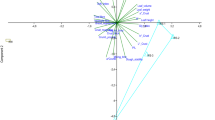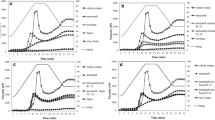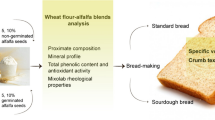Abstract
In this study the breadmaking potential of lupin flour from L. mutabilis after being debittered (DLF) and solid state fermented (FLF) was evaluated in lupin-wheat breads. Different levels of substitution (10, 15, 20%) were tested on dough rheology and the technological and nutritional (composition and in vitro digestibility indexes) properties of breads, as well as acceptability. Lupin weakened the dough during mixing, having shorter development time and stability, especially FLF. Less relevant was the effect of lupin flours along heating-cooling of the doughs recorded with the Mixolab. DLF and FLF significantly affected technological properties of the lupin-wheat breads at higher substitution (> 10%), particularly reducing bread volume, crust luminosity, crumb cohesiveness and resilience. Detrimental effects observed at the highest substitutions (20%) were diminished when using FLF, although breads received lower score due to the acidic taste detected by panelists. Both lupin flours provided lupin-wheat breads with rather similar composition, rising the average content of proteins, fat and dietary fiber by 0.8, 2.4, 6.5 %, respectively, compared to wheat breads. Likewise, lupin-wheat breads had significantly lower hydrolytic and glycemic indexes. Overall, debittered and fermented lupin could be used for enriching wheat breads, although better technological properties were observed with FLF.
Similar content being viewed by others
References
Betoret E, Rosell C (2020) Enrichment of bread with fruits and vegetables: Trends and strategies to increase functionality. Cereal Chem 97:9–19
Ballester D, Zacari I, Yhlez E (1984) Baking studies and nutritional value of bread supplemented with full-fat sweet lupine flour (L. albus cv Multolupa). J Food Sci 49:14–16
Villarino C, Jayasena V, Coorey R, Chakrabarti-Bell S, Johnson S (2016) Nutritional, health, and technological functionality of lupin flour addition to bread and other baked products: benefits and challenges. Crit Rev Food Sci 56:835–857
Mubarak A (2001) Chemical, nutritional and sensory properties of bread supplemented with lupin seed (Lupinus albus) products. Nahrung 45:241–245
Paraskevopoulou A, Chrysanthou A, Koutidou M (2012) Characterisation of volatile compounds of lupin protein isolate-enriched wheat flour bread. Food Res Int 48:568–577
Villarino C, Jayasena V, Coorey R, Chakrabarti-Bell S, Johnson S (2015a) Optimization of formulation and process of Australian sweet lupin (ASL)-wheat bread. Food Sci Technol-Leb 61:359–367
Villarino C, Jayasena V, Coorey R, Chakrabarti-Bell S, Foley R, Fanning K, Johnson S (2015b) The effects of lupin (Lupinus angustifolius) addition to wheat bread on its nutritional, phytochemical and bioactive composition and protein quality. Food Res Int 76:58–65
Villarino C, Jayasena V, Coorey R, Chakrabarti-Bell S, Johnson S (2014) The effects of bread‐making process factors on Australian sweet lupin‐wheat bread quality characteristics. Int J Food Sci Tech 49:2373–2381
Frick K, Kamphuis L, Siddique K, Singh K, Foley R (2017) Quinolizidine alkaloid biosynthesis in lupins and prospects for grain quality improvement. Front Plant Sci 8:87
Cortés-Avendaño P, Tarvainen M, Suomela J, Glorio-Paulet P, Yang B, Repo-Carrasco-Valencia R (2020) Profile and content of residual alkaloids in ten ecotypes of Lupinus mutabilis sweet after aqueous debittering process. Plant Foods Hum Nutr 75:184–191
Jiménez-Martínez C, Campos‐Mendiola R, Sánchez‐Espíndola M, Jiménez‐Aparicio A, Gutiérrez‐López G, Dávila‐Ortiz G (2009) Microstructural changes in Lupinus campestris seed in response to three thermal debittering treatments. J Sci Food Agric 89:2399–2404
Villacrés E, Álvarez J, Rosell C (2020) Effects of two debittering processes on the alkaloid content and quality characteristics of lupin (Lupinus mutabilis Sweet). J Sci Food Agric 100:2166–2175
Bartkiene E, Schleining G, Rekstyte T, Krungleviciute V, Juodeikiene G, Vaiciulyte-Funk L, Maknickiene Z (2013) Influence of the addition of lupin sourdough with different lactobacilli on dough properties and bread quality. Int J Food Sci Tech 48:2613–2620
Villacrés E, Quelal M, Jácome X, Cueva G, Rosell C (2020b) Effect of debittering and solid-state fermentation processes on the nutritional content of lupin (Lupinus mutabilis Sweet). Int J Food Sci Tech 55:2589–2598
AOAC (Association of Official Analytical Chemestry) (1995, 2000, 2005) Official Methods of Analysis
AACC Approved methods of the American Association of Cereal Chemistry (2003) 10th. St. Paul, Minnesota, U.S.A
Goñi I, Garcia-Alonso A, Saura-Calixto F (1997) A starch hydrolysis procedure to estimate glycemic index. Nutr Res 17:427–437
Watts B, Ylimaki G, Jeffery L, Elías L (1992) Basic methods for food evaluation. Ottawa, International Development Research. CIID, Ottawa, 159 p
Islam S, Ma W, Yan G, Gao L, Appels R (2011) Differential recovery of lupin proteins from the gluten matrix in lupin–wheat bread as revealed by mass spectrometry and two-dimensional electrophoresis. J Agric Food Chem 59:6696–6704
Rosell C, Cortez G, Repo-carrasco R (2009) Breadmaking use of Andean crops Quinoa, Kañiwa, Kiwicha and Tarwi. Cereal Chem 86:386–392
Pollard N, Stoddard F, Popineau Y, Wrigley C, Macritchie F (2002) Lupin Flours as Additives: Dough Mixing, Breadmaking, Emulsifying, and Foaming. Cereal Chem 79:662–669
Dervas G, Doxastakis G, Hadjisavva-zinoviadi S, Trianta N (1999) Lupin flour addition to wheat flour doughs and effect on rheological properties. Food Chem 66:67–73
López E, Goldner M (2015) Influence of storage time for the acceptability of bread formulated with lupine protein isolate and added brea gum. Food Sci Technol-Leb 64:1171–1178
Matos M, Sanz T, Rosell C (2014) Establishing the function of proteins on the rheological and quality properties of rice based gluten free muffins. Food Hydrocolloid 35:150–158
Campos J, El Dash A (1978) Effect of addition of full fat sweet lupine flour on rheological properties of dough and baking quality of bread. Cereal Chem 55:619–625
Ertaş N (2015) Technological and chemical characteristics of breads made with lupin sprouts. Qual Assur Saf Crop 7:313–319
Sedláková K, Straková E, Suchý P, Krejcarová J, Herzig (2016) Lupin as a perspective protein plant for animal and human nutrition–a review. Acta Vet Brno 85:165–175
Acknowledgements
The authors would like to acknowledge the financial support of the Cooperative Program for the Regional Agricultural Technology Fund (FONTAGRO) (Project FTG/RF-14893-RG, 2016–2018), Spanish Ministry of Science and Innovation (RTI2018-095919-B-C21), Generalitat Valenciana (Prometeo 2017/189) and the European Regional Development Fund (FEDER).
Author information
Authors and Affiliations
Corresponding author
Ethics declarations
Conflict of Interest
The authors declare that there is no conflict of interest regarding this publication.
Additional information
Publisher's Note
Springer Nature remains neutral with regard to jurisdictional claims in published maps and institutional affiliations.
Highlights
• L. mutabilis flour could be used as ingredient for making wheat breads.
• Debittering and solid-state fermentation lead to lupin flours with good breadmaking performance.
• Up to 10% wheat replacement with lupin does not affect bread properties.
• Lupine-wheat breads with fermented lupin flour (20%) presented an improved nutritional profile.
Rights and permissions
About this article
Cite this article
Villacrés, E., Cueva, P., Díaz, M. et al. Replacing Wheat Flour with Debittered and Fermented Lupin: Effects on Bread’s Physical and Nutritional Features. Plant Foods Hum Nutr 75, 569–575 (2020). https://doi.org/10.1007/s11130-020-00844-w
Published:
Issue Date:
DOI: https://doi.org/10.1007/s11130-020-00844-w




